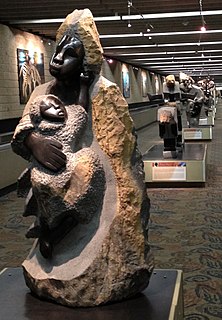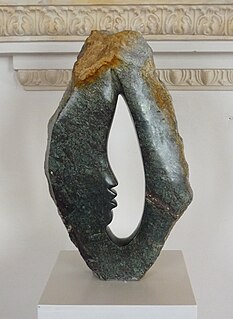
The Chapungu Sculpture Park is a sculpture park in Msasa, Harare, Zimbabwe, which displays the work of Zimbabwean stone sculptors. It was founded in 1970 by Roy Guthrie, who was instrumental in promoting the work of its sculptors worldwide. One way this was done was by exhibiting the sculptures in Botanical Gardens in a touring exhibition called "Chapungu: Custom and Legend — A Culture in Stone". The places visited include:

Dominic Benhura is a Zimbabwean sculptor.

Tapfuma Gutsa is a Zimbabwean sculptor.
Nicholas Mukomberanwa was a Zimbabwean sculptor and art teacher. He was among the most famous products of the Workshop School at the National Gallery of Zimbabwe and an art mentor and teacher to the Mukomberanwa Family of sculptors. His work has been exhibited in galleries around the world and he remains one of Zimbabwe's most famous artists.
Lawrence Mukomberanwa is a Zimbabwean sculptor.
Ennica Mukomberanwa is a Zimbabwean sculptor. The daughter of Grace Mukomberanwa and Nicholas Mukomberanwa, she was trained by the first generation of sculptures. Her work is exhibited in private collections and at galleries around the world. She is a third generation Zimbabwean sculptor. In 2004, she was awarded a prize which allowed her to travel to Stockholm, Copenhagen, Scotland, and Canada. She is a member of the Mukomberanwa family of sculptors. She is the daughter of Grace Mukomberanwa and Nicholas Mukomberanwa, who served as her mentor. She is the sister of sculptors Anderson, Netsai, Taguma, Tendai Mukomberanwa and Lawrence Mukomberanwa, and the cousin of Nesbert Mukomberanwa.
Bernard Matemera was a Zimbabwean sculptor. The sculptural movement of which he was part is usually referred to as "Shona sculpture", although some of its recognised members are not ethnically Shona. His whole professional career was spent at the Tengenenge Sculpture Community, 150 km north of Harare near Guruve.

Joram Mariga has been called the “Father of Zimbabwean Sculpture” because of his influence on the local artistic community starting in the 1950s and continuing until his death in 2000. The sculptural movement of which he was part is usually referred to as “Shona sculpture”, although some of its recognised members are not ethnically Shona.
John Takawira was a Zimbabwean sculptor. The background to the sculptural movement of which he was a leading member is given in the article on Shona art.

Henry Munyaradzi was a Zimbabwean sculptor. The sculptural movement of which he was part is usually referred to as "Shona sculpture", although some of its recognised members are not ethnically Shona. He worked initially at the Tengenenge Sculpture Community, 150 km north of Harare near Guruve, which he joined in 1967. In that Community, and ultimately in the wider world of lovers of Zimbabwean art, he was known simply as 'Henry'.
Lucky Office is a Zimbabwean sculptor.
Lincon Muteta,(born 18 January 1975) is a Zimbabwean sculptor.
Joseph Ndandarika was a Zimbabwean sculptor known for his figurative works.
Moses Masaya (1947–1995) was a Zimbabwean sculptor.
Garrison Machinjili is a Zimbabwean sculptor. He has been working at the Chapungu Sculpture Park since 1989, and has collaborated with many contemporary Zimbabwean sculptors, such as Charles Backford and Benard Nkanjo. His sculptures are generally abstract in nature, but are derived from natural subjects. arrison Machinjili Garrison was born in 1963 in Mazoe, Zimbabwe. He is related to the groundbreaking second-generation Zimbabwean sculptor, Tapfuma Gutsa, and it was during a visit to Tapfuma that he was introduced to stone sculpture. Garrison worked with Tapfuma in 1986. Initially, he sanded and polished sculptures in the final stages of completion. Later, he made his own sculptures, and found a strong personal style emerging during this inspiring early period. In late 1987, he had established his name as an important new talent in the Zimbabwean art scene, and he was invited to join the prestigious Chapungu Sculpture Village as a resident artist, where he remained until 1991 and returning again in 1999-2000. Group exhibitions include: - "African Odyssey: 50 Years of Zimbabwean Stone Sculpture", OXO Gallery, London, UK (2006) - "Custom and Legend: A Culture In Stone", Kew Gardens, London, UK (2000) - Inaugural exhibition at the Chapungu Gallery, Melbourne, Australia (1998) - Zuva Gallery, Scottsdale, Arizona, USA (1998

Sculpture and in particular stone sculpture is an art for which Zimbabwe is well known around the world.
Tendai Mukomberanwa is a Zimbabwean sculptor. The son of Grace Mukomberanwa and Nicholas Mukomberanwa, Tendai worked with his father from age 10 in his early childhood days. His artwork has been sold and exhibited worldwide. He continues sculpting at the family studios in Ruwa.
David Annesley is a British sculptor who rose to prominence in the 1960s.

Tengenenge is a community of artists and their families located in the Guruve District of Zimbabwe. It has achieved international recognition because of the large number of sculptors who have lived and worked there since 1966. These include Fanizani Akuda, Bernard Matemera, Sylvester Mubayi, Henry Munyaradzi and Bernard Takawira.

Ronika Tandi is a Zimbabwean sculptor.








